- Bernard Preston homepage
- Starch
- Lowering Blood Glucose
Lowering blood glucose
Lowering blood glucose without the use of drugs is a fascinating new domain of research; T2D can be put completely into remission[1].
This is a highly complex subject; I will endeavour to make it simpler for you to understand. Nevertheless expect to have those brain cells stretched. Every obese person and all diabetics should have an understanding of this matter.
I would suggest that those enjoying a naturally high fibre diet and low refined-starch foods need have few concerns on the subject. They are unlikely to suffer from T2D and can give this page the miss; but they are few and far between.
Less than 5% of people enjoying typical grocery store meals are getting the recommended daily allowance of fibre; at least 30 grams per day. It slows the release of food from the stomach; lowering blood glucose.
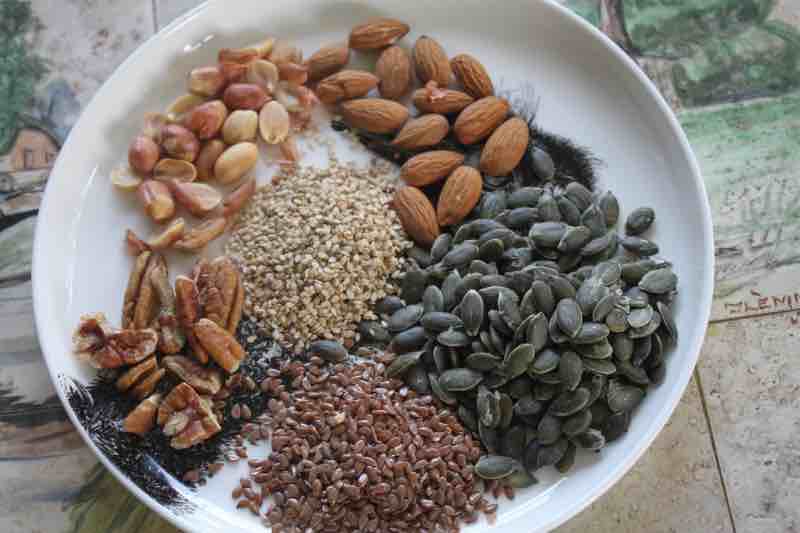
Nuts and seeds are particularly rich in natural dietary fiber; so are whole-grains such as grits and sourdough breads.
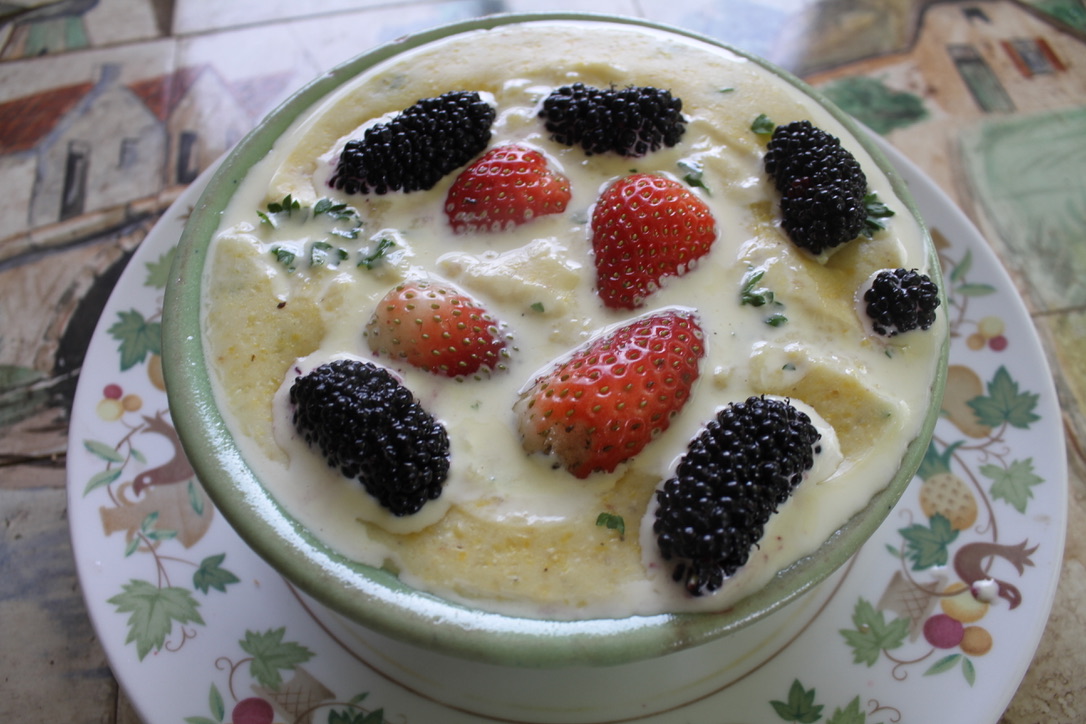 Cheesy grits with cream and berries
Cheesy grits with cream and berriesFor those who are insulin-resistant lowering blood glucose must be kept in focus; to this 100% wholegrain stone ground grits we add a little cheese, cream and parsley. The glycemic index is low; less than 50. The berries are the cherry on top.
High-fat dairy products significantly reduce the risk of colorectal cancer too.
The incretin hormones and DPP-4
There are two hormones produced in the stomach and small intestine that naturally lower blood glucose; they are secreted within minutes of swallowing food.
- GIP delays the emptying of the contents of the stomach into the small intestine which is where starches are digested; and the glucose formed is absorbed into the blood stream.
- GLP-1 on the other hand stimulates the pancreas to increase the production of insulin and reduce the secretion of glucagon; this lowers the levels of sugars in the blood stream. Its effectiveness is greatly impaired in those suffering from T2D. It also has receptors in several parts of the brain associated with appetite regulation; it plays an important role in satiation signalling when we've eaten enough.
Allowed to continue functioning indefinitely, these two hormones would dangerously lower blood glucose to the extent that the brain and other organs would run out of energy; coma would soon follow. So they are degraded within minutes by an enzyme called DPP-4; this is normal physiology within our bodies.
DPP-4 is rendered ineffective in various disease states such as obesity, cancer and generalised inflammation[3]; the action of the incretin hormones continues for too long. Hypoglycemia is likely; low blood sugar.
DPP4 is also depleted in those consuming highly glycemic snacks and meals; sugar, refined grains and ultra-processed foods.
"Ozempic maker Novo Nordisk is building a new $4B factory to meet global demand."
- Snacks, June 2024
Anti-inflammatory effect of DPP4
DPP4 also has a powerful anti-inflammatory effect beyond reducing the half life of the incretin hormones; it helps to break down the overly exuberant cytokines that have such a destructive influence in viral infections.
DPP4 is also depleted by inflammatory foods and during viral infections; the body is then unable to break down these cytokines associated with the destructive storm affecting the lungs and other organs.
DPP4 also helps prevent the consistently raised hormone called cortisol produced by chronic stress; that spikes blood glucose and can lead to T2D.
The amino acid called proline
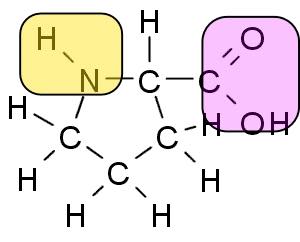
Proline residues play an important role in the proper functioning of DPP-4. Having a ring structure makes it difficult for enzymes in the stomach and small intestine to digest them completely. Should short chains of amino acids be absorbed into the blood stream they set up powerful inflammatory reactions.
Proline is the only amino acid having a ring structure.
It is particularly high in the plant proteins found in grains, known collectively as prolamines; gluten is one such example.
Almost without exception people find sourdough far more digestible; and DPP-4 can function normally sending satiety messages to the brain. It's no coincidence that in the five Blue Zones where longevity is the norm[6] that all breads are baked by this method.
The gluten is predigested by bacteria and yeasts in the culture even before it is consumed.
Proline is also very high in broths made with bones, the skin from chickens[4] and various animal meats; best is from those that are grass-fed.
This is profoundly important for the normal functioning of these hormones and enzymes such as DPP-4. It's all about lowering blood glucose; reducing inflammation in the body and not succumbing to viruses like HIV and Covid[3].
Gliptons
Gliptons are a class of drugs that inhibit DPP-4, prolonging the influence of the incretin hormones GIP and GLP1; that would promote the lowering of blood glucose in diabetics.
Unfortunately Gliptons have quite serious side effects, especially upper respiratory and throat infections; and of the urinary tract. Patients are also more likely to suffer from joint pains and swelling of the heart muscles; pancreatitis and hypersensitivity to bee-stings resulting in anaphalaxis.
There are better ways of lowering blood glucose than interfering with the normal hormonal cycles with medications like the Gliptons.
Pancreatitis
At the American Association of Clinical Endocrinology meeting in May, 2024 concerns were again expressed about deaths from pancreatitis after taking GLP-1 based therapies. There are better ways of lowering blood glucose.
Typical symptoms of pancreatitis are as follows.
- Severe epigastric and right upper quadrant pain.
- Radiation of pain to the midback.
- Nausea and vomiting.
Gluten
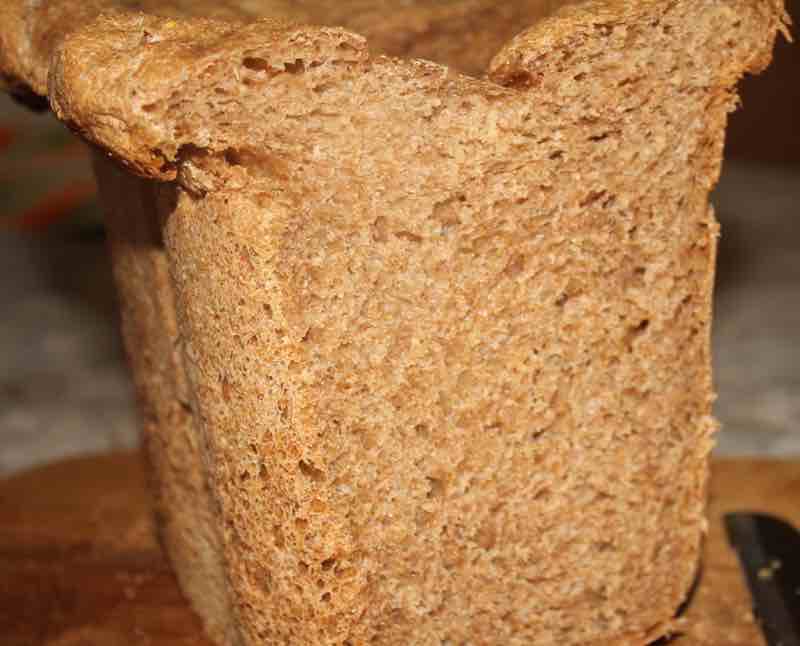 Sourdough bread made with 100% wholemeal is digestible, soft and very tasty.
Sourdough bread made with 100% wholemeal is digestible, soft and very tasty.Complete avoidance of gluten-rich breads, either because of indigestibility associated with proline or their high starch content is not necessary for those who enjoy only sourdoughs made from wholegrains; nor is it advisable.
Many nutritionists have pointed out that those avoiding gluten very often turn instead to refined foods to their great detriment. Anti-inflammatory DPP4 is reduced and processed starches increase blood glucose; cytokines have a field day setting up anger in our joints, muscles and capillaries. High cortisol further raises serum sugars.
Numerous studies have shown that gluten which has been hydrolysed by the enzymes in the sourdough method of baking has many beneficial virtues such as less muscle injury during exercise; and resistance to a hepatitis infection[5].
The tripeptides produced, rich in proline and glutamine both of which we may have difficulty with in gluten that has not been predigested, have a significant inhibitory effect on DPP-4; this means that lowering of blood glucose by the incretin hormones continues for longer causing hypoglycemia and wild swings in serum sugars.
Sourdoughs tend to be expensive; consider baking them yourself. The loaf above takes just five minutes to prepare, including grinding the flour. The taste, texture and digestibility are astounding; as is the price tag if you are willing to purchase a mill and source the wheat directly from a farmer. It costs around half a dollar to make.
But one slice of real bread is enough. A second may make you feel stuffed and give you indigestion.
In short a gluten-free diet may ironically increase inflammation in the body and interfere with blood glucose regulation.
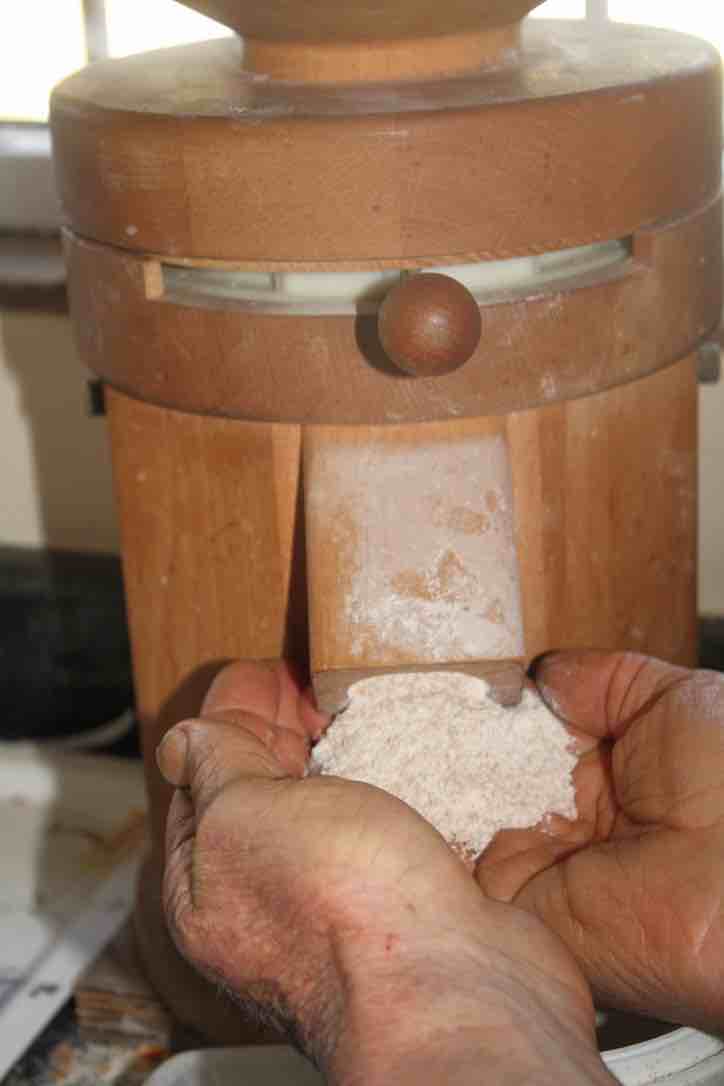
Freshly-ground 100% wholemeal flour is almost impossible to purchase; from your own mill it costs less than a quarter of the retail price. For those who bake sourdough bread themselves daily, the cost is paid off in around one year.
Ginger and turmeric
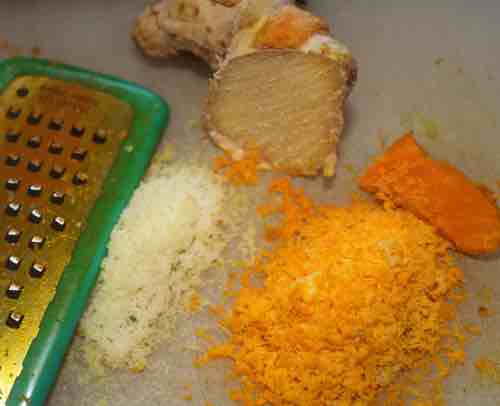 Add ginger and turmeric daily to your cooking
Add ginger and turmeric daily to your cookingResearchers have found that an enzyme in ginger is particularly efficient in hydrolising gluten. Currently it is being used orally in herbal medicine for enhancing immune function and stimulating insulin release for lowering blood glucose.
Whilst pharmaceutical companies are looking to use this property for novel new medications, you can simply grate fresh ginger and turmeric daily into your cooking.
It has long been known that fresh ginger has many benefits, especially for the diabetic. It is not however a substitute for avoiding refined carbs.
South African Indians eat prodigious amounts of ginger, turmeric and garlic; but the prevalence of T2D is extremely high because of their love of polished, precooked rice and cake flour for making soft rotis.
Exercise
Even a brisk ten minute walk after a starchy meal makes a very significant contribution to lowering blood glucose; it is especially effective after dinner at night.
Test yourself
In short lowering blood glucose is a complex and controversial subject. If you are obese, have diabetes or know that you are insulin-resistant with a raised HbA1c it is imperative that you test yourself regularly. Exactly how do unrefined high fibre carbs affect you personally? Can you enjoy sourdough bread? What about new potatoes?
Continuous Glucose Monitors are dropping in price and have become very user-friendly. Measuring your blood sugar every few minutes and recording it via blue tooth on your cellphone gives you immediate feedback on the response of your body to these carbs.
Use one periodically for two weeks.
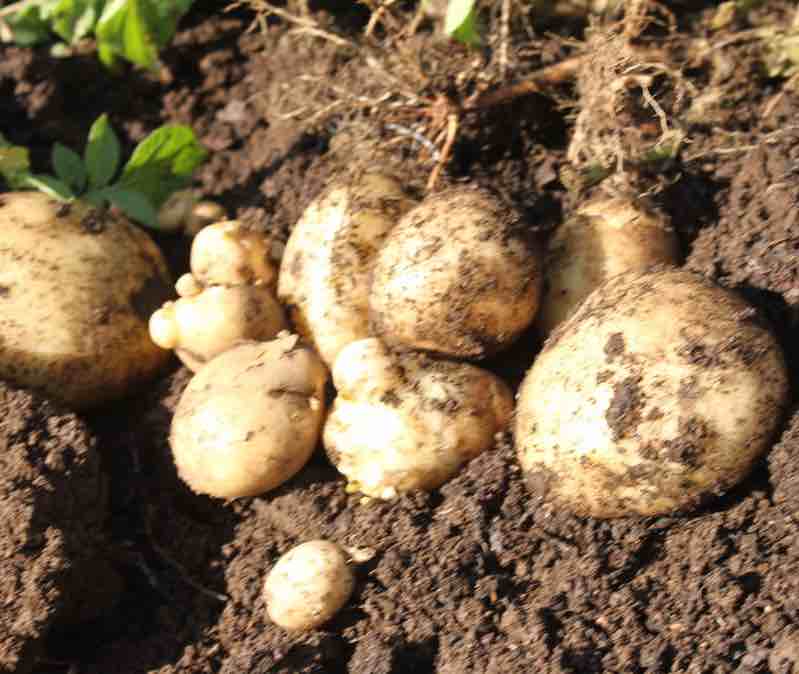
New potatoes have far less digestible starch; in moderation even diabetics can probably enjoy them but should test the response of their blood glucose.
The obese alas should drastically reduce all starches, even the good ones like new potatoes, butternut and sourdough bread; until they have shed those unwanted pounds.
Obesity
Is obesity a disease? The researchers have not made up their minds; it certainly predates the modern "industrial diet."
It is my conviction that the obese should not in the main feel guilty about their affliction. They have been lured by food companies into consuming the offering found in today's supermarkets; and many of the lies peddled about starches. Lowering blood glucose and keeping it down has become an arduous affair for the majority.
It need not be so.
For those enjoying a high fibre and low refined-starch diet it's not difficult at all; these foods supply satiety and slow gastric emptying.
But it does mean indulging in cake flour and sugary products only on high and holy days; cookies, delectable scones and slices of tarts.
On the other hand the obese know perfectly well what happens when they accept that second slice of chocolate cake; each has over ten teaspoons of sugar and about 110g of refined starch. Like all disease states, obesity is 10% genetic but mostly to do with lifestyle. We can reply "no thank-you; I have enjoyed an elegant sufficiency."
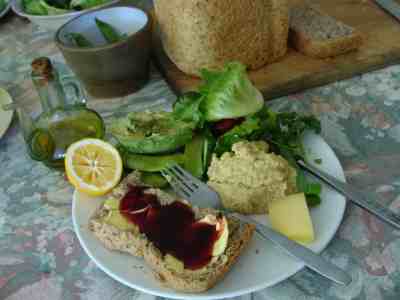
You will feel stuffed after a meal like this; one slice of true wholegrain bread is enough. The berry jam contains about 1 tsp of sugar; and many important phytonutrients. You will have very little inclination for dessert; the incretin hormones are at work "mediating satiety via central pathways to the brain[8]."
"A large body of data indicates that GLP-1 plays an important role in satiation signaling."
- International Journal of Obesity
Continuous glucose monitors
The continuous glucose monitor (CGM) is an amazing new device that will give important insights into lowering blood sugar; it enables you to see your levels in real time. Whilst designed for the diabetic, both types 1 and 2, it has huge benefits for the obese; and in fact for all of us who are insulin resistant. That is nearly 50% of the population enjoying modern grocery store foods.
A tiny disposable sensor placed simply by yourself on the skin measures glucose levels in the body; and then transmits the information wirelessly to your cellphone[9].
The device enables you immediately to see which foods are spiking your blood glucose, the effect of exercise and any medications you are taking. The savings would be vast; every diabetic would simply and easily be able to reduce the insulin and other drugs that have been prescribed.
Whilst they are expensive, if every person with elevated blood glucose had been able to monitor during the recent pandemic, millions of lives would have been saved. More than half of those who died were obese or diabetic.
There are two types.
- Intermittently scanned continuous glucose monitors (isCGM)
- Real-time continuous glucose monitors (rtCGM)
Whilst the diabetic person really should have this device indefinitely, we all could benefit by using a CGM for say a month or two; it would hugely reduce the comorbidities like heart and kidney disease. The immediate feedback of how an indulgence could threaten one's very being would give massive impetus to meaningful lifestyle changes.
Scientists are finding that CGMs are powerful tools that help patients make lifestyle changes based on their glucose levels.
The IMMEDIATE study[7] gave cogent support for the use of CGMs.
We know that genetic factors play an important role in making people susceptible to disease.
But in the end it is the interaction between genetic, lifestyle and environmental factors that leads to its manifestation.
Lowering blood glucose
Lowering blood glucose can be done naturally by our food choices; and taking short, brisk walks after starchy meals.
- How diet alone can achieve remission of type-2 diabetes
- Gliptons. DPP-4 inhibitors
- DPP4 in diabetes
- Best chicken bone broth recipe
- Production of a novel wheat gluten hydrolysate containing inhibitory tripeptides using ginger protease
- Blue Zone longevity
- The IMMEDIATE study
- Incretin hormones and the satiation signal
- The ultimate guide to continuous glucose monitoring
When browsing use right click and "Open Link in New Tab" or you may get a bad gateway signal.
What is the normal level of glucose in the blood?
- Normal fasting blood glucose first thing in the morning should be lower than 5.6mmol/L (100mg/dL).
- Two hours after a glucose challenge it should have dropped back below 7.8mmol/L (140 mg/dL).
- HbA1c is more controversial. Generally accepted is that it should not be above 5.5 but some authorities feel it is okay up to 6.5%.
A short brisk walk after dinner is most effective in lowering the FBG next morning.
Newsletter
Our newsletter is entitled "create a cyan zone" at your home, preserving both yourself and Mother Earth for future generations; and the family too, of course. We promise not to spam you with daily emails promoting various products. You may get an occasional nudge to buy one of my books.
Here are the back issues.
- Lifestyle and ideal body weight
- What are ultra-processed foods?
- Investing in long-term health
- Diseases from plastic exposure
- Intensive lifestyle management for obesity has limited value
- A world largely devoid of Parkinson's Disease
- The impact of friendly bacteria in the tum on the prevention of cancer
- There's a hole in the bucket
- Everyone is talking about weight loss drugs
- Pull the sweet tooth
- If you suffer from heartburn plant a susu
- Refined maize meal and stunting
- Should agriculture and industry get priority for water and electricity?
- Nature is calling
- Mill your own flour
- Bake your own sourdough bread
- Microplastics from our water
- Alternative types of water storage
- Wear your clothes out
- Comfort foods
- Create a bee-friendly environment
- Go to bed slightly hungry
- Keep bees
- Blue zone folk are religious
- Reduce plastic waste
- Family is important
- What can go in compost?
- Grow broad beans for longevity
- Harvest and store sunshine
- Blue zone exercise
- Harvest and store your rainwater
- Create a cyan zone at your home
Did you find this page interesting? How about forwarding it to a friendly book or food junkie? Better still, a social media tick would help.
- Bernard Preston homepage
- Starch
- Lowering Blood Glucose
Address:
56 Groenekloof Rd,
Hilton, KZN
South Africa
Website:
https://www.bernard-preston.com